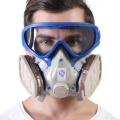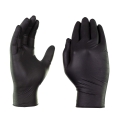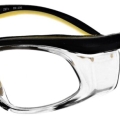Personal protective equipment
Using personal protection is essential when painting a car to safeguard against the hazards associated with chemicals and particles involved in the process. Here’s a comprehensive guide on the personal protective equipment (PPE) needed for car painting:
Personal Protective Equipment (PPE) for Car Painting:
-
- Purpose: Protects against inhaling toxic fumes and particulate matter.
- Type: A half-face or full-face respirator with appropriate filters for organic vapors and particulates is recommended. Disposable masks can offer some protection but are not as effective as respirators.
- Usage: Ensure a proper fit and seal. Replace filters as recommended by the manufacturer.
- Sources: OSHA recommends using respirators for protection against isocyanates and other harmful chemicals commonly found in automotive paint .
-
- Purpose: Shields skin from paint splashes, solvents, and sanding dust.
- Type: Disposable coveralls, long-sleeved shirts, long pants, and a spray suit. Choose materials resistant to solvents and chemicals.
- Usage: Wear clothing that covers all exposed skin. Ensure the coveralls fit snugly but allow for freedom of movement.
- Sources: NIOSH emphasizes the importance of protective clothing to prevent skin contact with harmful chemicals .
-
- Purpose: Protects hands from solvents, paint, and other chemicals.
- Type: Nitrile gloves are preferred due to their resistance to chemicals. Latex gloves are less resistant and can cause allergies.
- Usage: Ensure gloves are intact without any tears. Change gloves if they become contaminated.
- Sources: The CDC recommends using gloves when handling chemicals to avoid skin absorption .
-
- Purpose: Shields eyes from paint overspray, solvents, and dust.
- Type: Safety goggles or a full-face shield. Ensure the eye protection is rated for chemical exposure.
- Usage: Wear goggles at all times when mixing, spraying, or sanding.
- Sources: The American National Standards Institute (ANSI) outlines requirements for eye protection to prevent chemical splashes .
-
Hearing Protection:
-
Ventilation:
- Purpose: Reduces the concentration of airborne chemicals and particles.
- Type: Use spray booths with proper ventilation systems. Ensure good airflow in the workspace.
- Usage: Always paint in well-ventilated areas. Use exhaust fans and open windows if a spray booth is unavailable.
- Sources: OSHA highlights the importance of adequate ventilation to reduce exposure to hazardous chemicals .
Best Practices:
- Regular Maintenance: Regularly inspect and maintain your PPE. Replace any damaged or worn-out equipment.
- Training: Ensure all individuals involved in the painting process are trained on the proper use and maintenance of PPE.
- Hygiene: Wash hands and face thoroughly after painting. Avoid eating, drinking, or smoking in the painting area.
- Emergency Procedures: Be familiar with the location and proper use of emergency equipment such as eyewash stations and showers.
By adhering to these guidelines and using appropriate personal protective equipment, you can significantly reduce the health risks associated with car painting.





